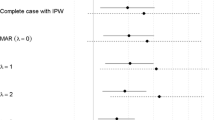Abstract
A cohort of all school children aged 16 years in 1983 (n=2194, 96.7%) in Tampere, Finland were studied at 16, 22 and 32 years of age by self-reported questionnaires. The non-response pattern was considered by modelling the individual response probability by panel year and gender. Gender and school performance at age 16 years were the most important predictors of non-response. They explained away the effect of all other variables at 16 and 22 years, except for earlier non-response at age 22. However, the ability of the models to predict non-respondents was very poor. The effect of attrition for the estimation of depression prevalence was evaluated first by longitudinal weighting methods used commonly in survey studies and then by Markov chain Monte Carlo (MCMC) simulation of the missing depression status. Under the missing-at-random assumption (MAR), both applied correction methods gave estimates of roughly the same size and did not significantly differ from the observed prevalence of depression. No indication of informative missingness was found. We therefore conclude that attrition does not seriously bias the estimation of depression prevalence in the data. In general, non-response models, which are needed to correct for informative missingness, are likely to have poor ability to predict non-response. Therefore, the plausibility of the MAR assumption is important in the presence of attrition.
Similar content being viewed by others
References
W Eaton J Anthony S Tepper A Dryman (1992) ArticleTitlePsychopathology and attrition in the epidemiologic catchment area surveys. Am J Epidemiol 135 1051–1059
L Koivusilta A Rimpelä V Andres (2003) ArticleTitleHealth behaviours and health in adolescence as predictors of educational level in adulthood: A follow-up study from Finland. Soc Sci Med 5 577–593 Occurrence Handle10.1016/S0277-9536(02)00405-7
A Oldehinkel H Wittchen P Schuster (1999) ArticleTitlePrevalence, 20-month incidence and outcome of unipolar depressive disorders in an community sample of adolescents. Psychol Med 29 655–668 Occurrence Handle10.1017/S0033291799008454
A-M Pietilä M-R Järvelin (1995) ArticleTitleHealth and social standing of young men viewed in light of information on their childhood and adolescence. Int J Nurs Stud 32 545–555 Occurrence Handle10.1016/0020-7489(95)00018-6
Graaf R de R Bijl F Smit A Ravelli W Vollebergh (2000) ArticleTitlePsychiatric and socioeconomic predictors of attrition in a longitudinal study: The Netherlands mental health survey and incidence study (NEMESIS). Am J Epidemiol 152 1039–1047 Occurrence Handle10.1093/aje/152.11.1039
R Little D Rubin (2002) Statistical analysis with missing data, 2nd edn. Wiley New York
H Aro U Palosaari (1992) ArticleTitleParental divorce, adolescence, and transition to young adulthood: A follow-up study. Am J Orthopsychiatry. 62 421–429
T Huurre H Aro O Rahkonen (2003) ArticleTitleWell-being and health behaviour by parental socioeconomic status. A follow-up study of adolescents aged 16 until age 32 years. Soc Psychiatry Psychiatr Epidemiol 38 249–255
Central Statistical Office of Finland. Classification of occupations. Helsinki, Central Statistical Office of Finland, 1975.
H Aro (1988) ArticleTitleParental discord, divorce and adolescent development. Eur Arch Psychiatry Neurol Sci 237 106–111 Occurrence Handle10.1007/BF00382374
M Pelkonen M Marttunen H Aro (2003) ArticleTitleRisk for depression: A 6-year follow-up of Finnish adolescents. J Affect Disord 77 41–51 Occurrence Handle10.1016/S0165-0327(02)00098-8
AT Beck RW Beck (1972) ArticleTitleScreening depressed patients in family practice. A rapid technic. J. Postgrad Med 52 81–85
RK Kaltiala-Heino M Rimpelä P Rantanen P Laippala (1999) ArticleTitleFinnish modification of the 13-item Beck Depression Inventory in screening an adolescent population for depressiveness and positive mood. Nord J Psychiatry 53 451–457 Occurrence Handle10.1080/080394899427700
Mattlar C-E, Raitasalo R, Putkonen A-R, et al The prevalence of depression in a random sample of Finns, and the association of depression with various cognitive functions. Abstract of the Eleventh International Meeting of the Epidemiological Association (No. 629). International Association, Helsinki, 1987.
S Aro (1981) ArticleTitleStress, morbidity and health-related behaviour: A five-year follow-up study among mental industry employees Scand J Soc Med 9 S25
O Paronen M Pasanen P Rantanen S Aro (1982) ArticleTitleTest–retest study of psychosomatic symptoms among 14-15 year-old schoolchildren (English summary). Sosiaalilääketieteellinen Aikakauslehti 19 234–239
M Rimpelä A Rimpelä M Pasanen (1982) ArticleTitlePerceived symptoms among 12–18-year-old Finns (English summary). Sosiaalilääketieteellinen Aikakauslehti 19 219–233
M Rosenberg (1965) Society and the adolescent self-image. Princeton University Press Princeton
Diggle P, Heaqerty P, Liang K-Y, Zeger S. Analysis of longitudinal data, 2nd edn. Oxford Press, 2002.
J Robins A Rotnitzky L Zhao (1995) ArticleTitleAnalysis of semiparametric regression models repeated outcomes in the presence of missing data. J Am Stat Assoc 90 106–120
P Rosenbaum D Rubin (1983) ArticleTitleThe central role of the propensity score in observational studies for causal effects. Biometrika 70 IssueID9 41–55
Author information
Authors and Affiliations
Corresponding author
Rights and permissions
About this article
Cite this article
Eerola, M., Huurre, T. & Aro, H. The problem of attrition in a Finnish longitudinal survey on depression. Eur J Epidemiol 20, 113–120 (2005). https://doi.org/10.1007/s10654-004-1657-0
Received:
Issue Date:
DOI: https://doi.org/10.1007/s10654-004-1657-0



